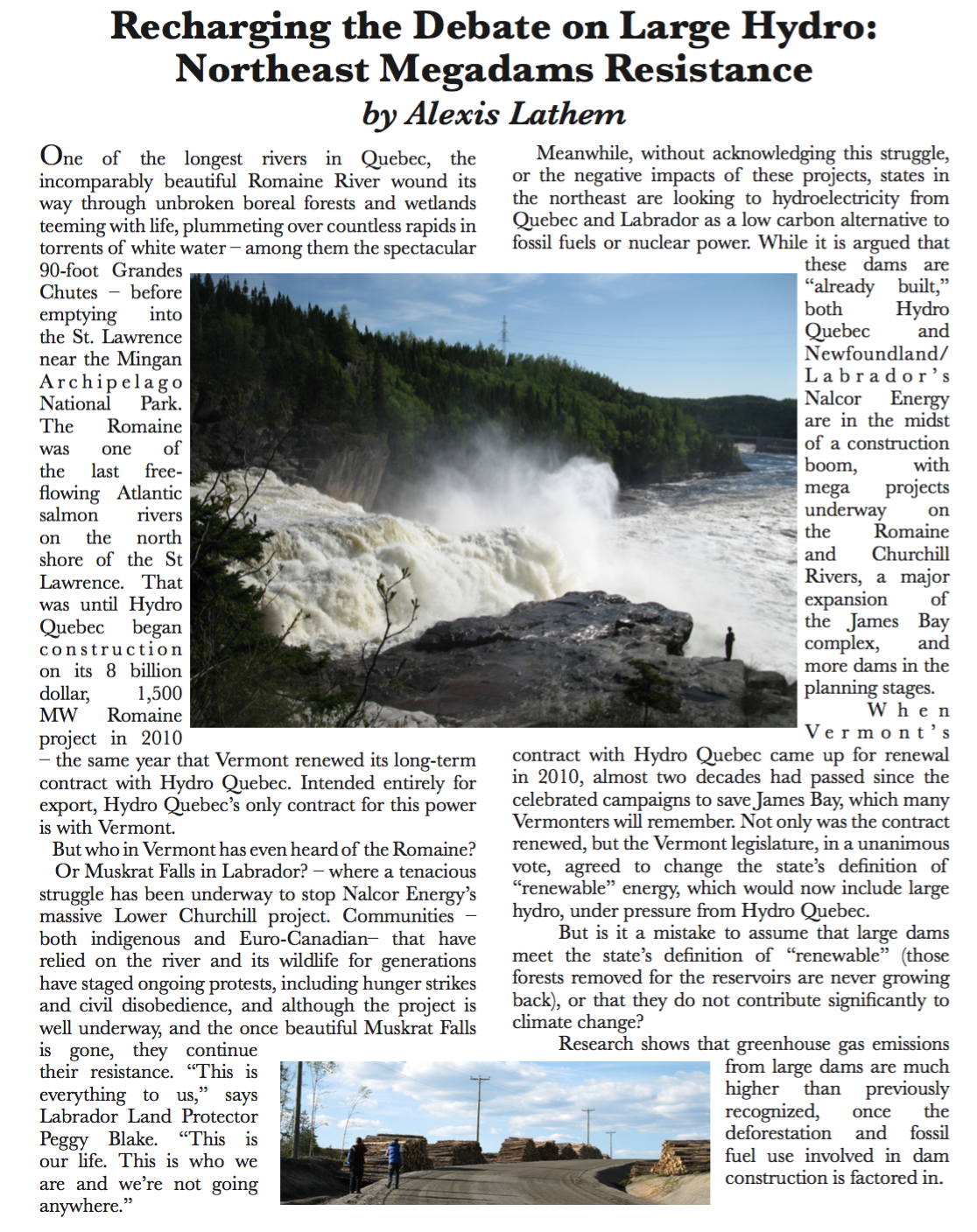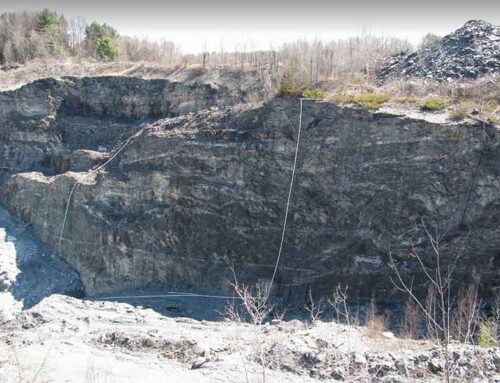Recharging the Debate on Large Hydro: Northeast Megadams Resistance
by Alexis Lathem
One of the longest rivers in Quebec, the incomparably beautiful Romaine River wound its way through unbroken boreal forests and wetlands teeming with life, plummeting over countless rapids in torrents of white water – among them the spectacular 90-foot Grandes Chutes – before emptying into the St. Lawrence near the Mingan Archipelago National Park. The Romaine was one of the last free-flowing Atlantic salmon rivers on the north shore of the St Lawrence. That was until Hydro Quebec began construction on its 8 billion dollar, 1,500 MW Romaine project in 2010 – the same year that Vermont renewed its long-term contract with Hydro Quebec. Intended entirely for export, Hydro Quebec’s only contract for this power is with Vermont.
But who in Vermont has even heard of the Romaine?
Or Muskrat Falls in Labrador? – where a tenacious struggle has been underway to stop Nalcor Energy’s massive Lower Churchill project. Communities – both indigenous and Euro-Canadian– that have relied on the river and its wildlife for generations have staged ongoing protests, including hunger strikes and civil disobedience, and although the project is well underway, and the once beautiful Muskrat Falls is gone, they continue their resistance. “This is everything to us,” says Labrador Land Protector Peggy Blake. “This is our life. This is who we are and we’re not going anywhere.”
Meanwhile, without acknowledging this struggle, or the negative impacts of these projects, states in the northeast are looking to hydroelectricity from Quebec and Labrador as a low carbon alternative to fossil fuels or nuclear power. While it is argued that these dams are “already built,” both Hydro Quebec and Newfoundland/Labrador’s Nalcor Energy are in the midst of a construction boom, with mega projects underway on the Romaine and Churchill Rivers, a major expansion of the James Bay complex, and more dams in the planning stages.
When Vermont’s contract with Hydro Quebec came up for renewal in 2010, almost two decades had passed since the celebrated campaigns to save James Bay, which many Vermonters will remember. Not only was the contract renewed, but the Vermont legislature, in a unanimous vote, agreed to change the state’s definition of “renewable” energy, which would now include large hydro, under pressure from Hydro Quebec.
But is it a mistake to assume that large dams meet the state’s definition of “renewable” (those forests removed for the reservoirs are never growing back), or that they do not contribute significantly to climate change?
Research shows that greenhouse gas emissions from large dams are much higher than previously recognized, once the deforestation and fossil fuel use involved in dam construction is factored in.
Moreover, changes in land use and the loss of forests from secondary activities – logging and mining – that follow are never factored at all. Or the 1,000 mile-long clearcuts for new transmission.
Since the cancellation of James Bay II in 1994, Hydro Quebec has been out of the spotlight, but it has not stopped building dams. In the same year, it began construction on the 800 MW SM3 project, a project that was bitterly opposed by the region’s indigenous people, the Innu. While Hydro Quebec put its project of the century “on ice,” it proceeded, dam by dam and river by river, to expand upon the existing James Bay hydroelectric complex. The newest addition to this complex (this time with the Cree’s approval) is the 900 MW Eastmain project, which consists of four major dams and 74 dikes, and the diversion of three rivers – Rupert, Lemare, and Nemaska – into the existing Eastmain reservoir. Four hydroelectric complexes with four reservoirs are under construction on the Romaine. Once complete, HQ will have flooded an area the size of the state of Vermont.
As we mark the 25th anniversary of the Cree’s success with the cancellation of James Bay II (a much larger project than the expansion to which the Cree consented), a grassroots movement is growing in the region, demanding that we revisit the questions that the Cree encouraged us to ask: Should we be concerned only with environmental degradation in our own backyards? Should Vermont law be allowed to consider impacts of our consumption beyond our borders? Should energy from large dams be considered “renewable’? If rivers are destroyed while we look away, does this mean the damage is any less real?
The newly formed Northeast Megadam Resistance Coalition, formed in the wake of the Labrador Land Protectors and Grand River Keepers 2017 Megadam=Mega Damage Northeast speaking tour, is working to recharge this debate, and to oppose new transmission corridors that will encourage new dam construction in the north. After years of campaigning by residents of towns in the line of fire, the proposed 192 mile-long Northern Pass—which would have carried electricity from Quebec to Massachusetts through the length of New Hampshire –was denied its permits by state regulators. Eager to import Quebec’s “renewable” power, Massachusetts is now looking to Maine, where the proposed 142 mile-long New England Clean Energy Connect is up against similar opposition. Alternative transmission lines are also in the works, including the Champlain Hudson Power Express, which would carry power under Lake Champlain and the Hudson River, and the Atlantic Link, connecting Maine and New Brunswick.
Vermont boasts that it has the highest percentage of low-carbon electricity generation and consumption in the nation – without acknowledging that most of our “renewable” power comes from large dams hundreds of miles away. Organizations working towards the one-hundred-percent renewable energy goal have been too willing to turn a blind eye to the impacts of large dams that are smuggled into the “renewable” energy mix with all their consequences. The NE Megadam Resistance Coalition is bringing large hydro back into the energy debate. The silent support of mega projects, and our heavy reliance on this source of power, is standing in the way of true solutions to the climate crisis.
For more information, visit us at northeastmegadamresistance.org. Contact us at info.northeastmegadamsresistance@gmail.com.
Alexis Lathem is the coordinator for Northeast Megadam Resistance Coalition








